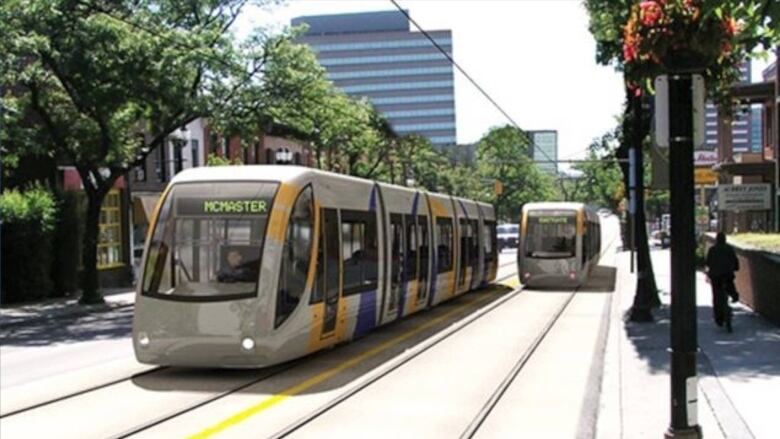Feds, province pledge $3.4B for Hamilton LRT, but city will have to pay operating costs
'No deal' for bus rapid transit, only LRT, federal and provincial ministers say

The federal and provincial governments will spenda combined $3.4 billion to build a light-rail transit system in Hamilton, but city council will likely still have to buy into the plan.
Catherine McKenna,federal minister of infrastructure and communities,andCaroline Mulroney, Ontario minister of transportation, announced the joint commitment Thursday morning.
The money, which amounts to $1.7 billion per level of government, will cover the cost of buildinga 14-kilometre line from McMaster University in the west end to Eastgate Square in Stoney Creek. The line would run alternately down King and Main streets.
"Now we need the City of Hamilton to formalize their contribution to the ongoing operation and maintenance of LRT, as was always the plan," Mulroneysaid.
LRT or no deal, sayministers
The commitment amounts to a $1.7-billion new commitment from Ottawa, and $700 million more than the province initially said it would cover.
"It's going to be awesome," McKenna said during a 10 a.m. Zoom announcement.
"The condition of these investments is shovel-ready projects, andwe have a shovel-ready project right here in Hamilton."
Both ministers were clear that the money is only available for an LRT, and that bus rapid transit (BRT) system isn't part of the picture.
Should city council try vying for a BRT, "there's no deal," said McKenna.
"Our partnership is for an LRT," Mulroney echoed.
Mayor Fred Eisenberger said while he certainly wanted it to happen "sooner," he thought there couldn't be a "better time" for an LRT to be built in the city.
"Timing is everything," he said, adding that the funding was "nothing but a win."
WATCH: Federal and provincial governments announce LRT funding:
Eisenberger estimated that the LRT project would create 7,000 jobs. If a company was offering that many, he said, "we would move heaven and earth to make sure that would happen."
A critical piece, he said, will be the memorandum of understanding, which will require a vote from council.
Route is set in stone
"I'm optimistic," Eisenberger said, noting that the city will "see what happens in the coming days."
Mulroney cancelled the LRT project, which Metrolinx had already spent $165 million on, in December 2019, saying it had gone over budgetand the burden on Hamilton would have been "not acceptable." The province would still spend a previously committed $1 billion on Hamilton transit, she said.
But the federal pledge, part of $12 billion in transit projects for the GTHA, has revived the LRT plan, which has mixed support on council.
The plan will stimulate economic growth, create jobs and create "desperately needed capacity" along the line, Mulroney said. The province will work with the city "in the coming weeks."
While the plan needs to be updated such as looking at 2021 prices prior to going to request for proposals (RFP)and reviewing the exact location of stops sources with knowledge of the announcement say its route is set in stone.
No private sector funding
The contribution means no private sector financing will be needed, government sources say, though delivery models have yet to be decided.
Eric Tuck, president of Amalgamated Transit Union (ATU) Local 107, which represents HSRdrivers, said that "unanswered questions" and conversations happening behind "closed doors" leaves the union with concerns.
He said the union has operating and maintenance rights along that route and wants it to be "locally ran and controlled." Private operation is a "non-starter," he said.
"If it's given to a private company, our experience is...we lose all control over the fares, we lose all control over the level of service and the level of maintenance," he said. "These types of systems are run into the ground...if they aren't being maintained properly, you can have some real disasters."
The LRT's origins date back to 2007, when the city used a Metrolinx grant for an environmental assessment. There have been at least three other versions of the route, but the McMaster-to-Eastgate route marks a return to the original plan.
WATCH: Minister McKenna says Hamilton LRT is 'going to happen':
In 2015, the then-Liberal provincial governmentled by Kathleen Wynne announced $1 billion to build the system.But the new Doug Ford PC government cancelled the project in December2019, saying it would go over budget.
Eisenbergercalls the announcement for Hamilton "getting our fair share."
While the province previously priced the LRT at around $5 billion, other reports have suggested lower costs. A Turner and Townsend report obtained by CBC Newsshowed capital costs running around $2.32 billion and $818.8 million in operating, maintenance and life cycle costs.
Part of the deal, McKenna said, will involve numerous conditions such as affordable housing and community benefit agreements, though no further details were provided.
Keeping housing affordable
Ward 3 councillor Nrinder Nannsaid residents want to have a voice in these benefits.
"What does affordable housing mean at the end of the day?" she said, questioning whether it could mean dedicating a percentage of development along the strip to affordable housing. That prompts other questions, she said, like whether it would be market or rent-geared-to-income housing.
"Those are the kinds of details that I know residents care deeply about," she said.
When asked about hesitancy, Nann said it would be imperative that residents are clearly informed about what the funding means, timelines for potential construction, and how businesses can keep doors open along the corridor.
"I don't want to see the city miss out on this opportunity," she said.
With files from Samantha Craggs













_(720p).jpg)


 OFFICIAL HD MUSIC VIDEO.jpg)
.jpg)



























































































